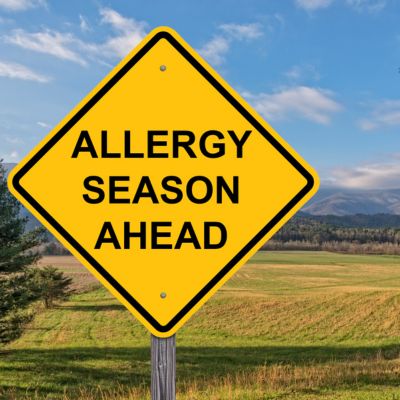Eye allergies are common in Knoxville due to our geography and fluctuating climate. Recognizing the signs of allergies is crucial for timely intervention and preventing discomfort. Prompt identification enables effective management for a comfortable and allergy-free experience in Knoxville.
Signs you have eye allergies include:
- Itchiness
- Redness
- Tearing or watery eyes
- Swelling
- Sensitivity to light
Signs You Have Eye Allergies
For those with allergies, spring means a lot of itching, redness, and congestion. But many of us also experience varying degrees of eye discomfort from allergies.
The most common signs you have eye allergies include:
- Itchiness
- Redness
- Tearing or watery eyes
- Swelling
- Sensitivity to light
Some people also experience swollen eyelids along with these symptoms. It’s also common to wonder if you have dry eye syndrome or allergies as both can have similar symptoms.
It’s difficult to self-diagnose allergies versus dry eye syndrome. Fortunately, Dr. Travis Thompson and Dr. Catherine Abbott can diagnose allergies by examining the conjunctiva. That’s the mucous membrane covering the front of your eye and lines the inside of your eyelids.
If they see a lot of little bumps in your eyelids (papillae), you have eye allergies. They can also diagnose dryness by putting a drop of special yellow dye in your eye. The dye reveals any signs of dry patches.
It’s possible to have eye allergies and dry eyes. That’s why it’s a good idea to be examined for both conditions so your symptoms are treated. At Hardin Valley Eyecare & Optical, we are proud to offer the latest technology in diagnosing and treating dry eyes using heat masks, warm compresses, eyelid cleaners, doxycycline, and intense pulsed light (IPL) treatment.
Causes of Eye Allergies
Eye allergies (allergic conjunctivitis) occur when the eyes react to environmental allergens. These allergens can include:
- Pollen
- Dust mites
- Mold spores
- Certain chemicals
Pet dander and dust mites are also common allergens that can trigger eye allergies. Pet dander consists of tiny skin flakes shed by animals. Dust mites thrive in bedding, upholstery, and carpets. They can induce allergic reactions similar to those caused by pollen or mold spores.
If you’re sensitive to allergens, your body’s immune system perceives them as invaders. This causes the body to mount an immune response. Mast cells in the conjunctiva release histamine and other inflammatory substances. Histamine causes dilation of blood vessels in the eyes, causing redness and irritation.
Histamine also triggers the production of mucus and tears, resulting in symptoms like:
- Burning sensation
- Blurry vision
- Mucous discharge
Overall, allergies are caused by the body’s immune system overreacting to harmless substances. This leads to inflammation and the characteristic symptoms of allergic conjunctivitis.
How To Reduce Symptoms Of Eye Allergies
Unfortunately, you can’t control outdoor allergens. However, there are measures you can take to minimize the effects on your eyes. Here are 5 tips to alleviate eye allergy symptoms:
- Wear glasses instead of contact lenses
- Take oral antihistamines
- Clean your floors with a damp cloth
- Keep windows closed and run the air conditioner
- Use artificial tears
- Take mast cell stabilizers
1. Wear Glasses Instead of Contact Lenses
Contact lenses are great for seeing clearly without glasses. Unfortunately, they can also collect pollen and other debris over time that causes dry eyes. In these cases, switching from reusable lenses to glasses can help reduce your dry eye symptoms.
2. Take Oral Antihistamines
Oral antihistamines help block the action of histamine. By inhibiting its effects, antihistamines ease itching, redness, and other allergic symptoms.
3. Clean Your Floors with a Damp Cloth
Cleaning floors with a damp cloth can capture and remove allergens. It also prevents allergens from becoming airborne, minimizing their presence indoors. This reduces the risk of triggering allergic reactions in sensitive individuals.
4. Keep Windows Closed and Run the Air Conditioner
Keeping windows closed and running the air conditioner limits outdoor allergens indoors. The air conditioner filters and circulates air. This traps allergens and maintains a controlled environment with lower allergen levels.
5. Use Artificial Tears
Artificial tears lubricate and moisturize the eyes, providing relief from allergic reactions. Additionally, they help flush out allergens from the eye surface. This soothes inflammation and reduces the severity of allergic symptoms.
6. Mast Cell Stabilizers
Mast cell stabilizers may be necessary when other treatments fail. They prevent mast cells in the eyes from releasing histamine that causes inflammation. By easing this response, mast cell stabilizers provide long-term relief from eye allergies.
Do you need help treating your eye allergies in Knoxville, TN? Contact us today to schedule your appointment!
Spring brings allergens that cause itching, redness, and congestion, especially in eye allergies. Symptoms like itchiness and swelling can mimic dry eye syndrome, needing expert diagnosis. Allergic conjunctivitis from pollen and dust mites triggers histamine release. Taking antihistamines, cleaning, and using artificial tears provide relief in Knoxville’s allergy seasons.
Hardin Valley Eyecare & Optical has been serving Knoxville since 2009. Located at 10904 Spring Bluff Way, you can schedule an appointment online or call us at (865) 888-0892.
*Editor’s Note: This blog has been updated for new information and clarity since it was originally published in August 2021





